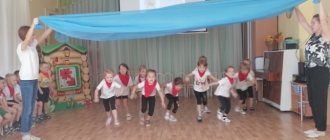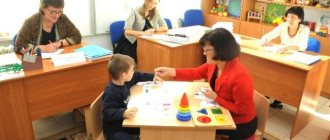Consultation for parents “The influence of playing with building materials on the development of a child”
Potapova Elena Anatolyevna
Consultation for parents “The influence of playing with building materials on the development of a child”
Preschool childhood is a short but very important period in the development of a child’s personality.
It is during these years that the child acquires initial knowledge about the life around him, his character develops, skills and habits of correct behavior are developed, and a certain attitude towards people and work begins to form.
As you know, the main activity of preschool children is play. In the process, the games develop - the spiritual and physical qualities of the child.
And games with building materials
promote: mental and sensory development of children.
By working with it, children learn the shape, color of objects, their size, acquire elementary spatial concepts, and provide an opportunity for the development of the creative side of the intellect.
These games don’t get boring for a long time, as they have great variety, variety of combinations, and help the child’s creative self-expression.
In the process of playing with building materials, children learn to name in one word the characteristics of objects with which they are already familiar, children’s speech develops, and their vocabulary expands.
As in any activity, there are children for whom construction comes very easily, that is, they really like to make various buildings - they already have the perseverance necessary for this, and the ability to see a generalized image, and not individual details.
But there are also children who need your help in creating any building.
For the development of such games, appropriate conditions are necessary. The most important of them is teaching simple constructive skills.
Taking this into account, you can organize such games - activities at home, where each participant performs his own task.
We recommend that you organize such games with your child, as children love joint activities, especially with dad and mom.
Those who say that children don’t like to build are wrong. Children just need to be shown how to do it correctly. Sit with the children, show that you are interested in this, and together add objects to the game.
To do this, purchase the necessary building material.
A wide selection of construction sets in our stores gives you, dear parents, the opportunity to purchase exactly the one that will interest your child.
Recommendations for parents:
— Parents should remember the first impression of the game. How you present a new game is very important;
— When playing with building materials, make sure that children finish what they start;
- Avoid very detailed and suggestive explanations and demonstrations during construction;
- If you see that something is not working out for a child, and the desire to build disappears, help him - tell him what needs to be done to complete the building;
— When playing games with building materials, it is unacceptable to change the sequence of the game at your own discretion;
- Upon completion of the construction, ask the child what parts the building was made of, how many bricks were needed, etc.;
- Play around with the building and praise the child.
Conclusion: Playing with building materials and various construction sets will help your child develop:
- fine motor skills;
- spatial orientation - an idea of the location of objects in space and relative to each other;
- imagination;
- Creative skills;
- learn a lot of new things;
— improve basic technical skills;
— activate the dictionary.
Consultation “Construction games in preschool educational institutions”
Consultation for teachers
Construction game
in the development of preschool children
Educator: S.B. Turygina
Construction game
in the development of preschool children
Construction game is a type of children’s activity, the main content of which is the reflection of the surrounding life in various buildings and related actions.
Children acquire basic construction skills in design classes: they master the elementary structure of those objects that can be created - the walls of a house, the roof, windows, etc.
Construction games are practical activities aimed at obtaining a specific, pre-conceived product. Children's construction is closely related to play and is an activity that meets the interests of the child.
In preschool pedagogy, construction is considered as a means of all-round development of the child:
Mental development
The child develops sensory abilities that develop most successfully in productive activities, in particular in construction. By constructing, the child learns to distinguish the external qualities of an object or sample (shape, size, structure, etc.); he also develops cognitive and practical actions.
In design, the child, in addition to visual perception of the quality of the object, actually, practically disassembles the sample into parts, and then assembles them into a model (this is how he carries out both analysis and synthesis in action). Thus, the ability to compare, perform visual analysis, and include thinking processes in the process of perception is formed.
In playing with building materials, children develop an interest in technology and develop their powers of observation; children acquire technical knowledge and become familiar with the properties of geometric bodies.
Labor education
Playing with building materials is especially close to work activity. They instill in children qualities that directly prepare them for work: the ability to set goals; plan your work, select the necessary material, critically evaluate the results of your work and the work of your comrades, take a creative approach to achieving your goal.
In the process of construction activities, hard work, independence, initiative, and a responsible attitude to work develop. When organizing and conducting games in kindergarten, there are great opportunities for developing the initial skills of friendly work in a team.
Speech development
In games with building materials, a large role belongs to the activity of the hand, associated with the active work of consciousness. Thanks to the joint activity of the hand, brain and speech apparatus, a person has the opportunity to influence the outside world, learning the laws of its development.
In a kindergarten setting, construction games help children improve their speech: they share their ideas, explain their actions, and suggest this or that solution. The vocabulary is expanding.
Physical education
Construction games are also valuable because they bring great emotional pleasure to children. During the game, children become embodied in their favorite characters: either this is a pilot building his own plane; or a captain, heatedly discussing with his sailors the details of a steamship under construction, on which a long voyage is proposed.
Constant exercise in a wide variety of movements, accompanied by an emotional uplift, helps these movements become fast, dexterous, and easily subject to the control of the eye. The coordinated work of individual muscles, especially flexors and extensors, improves.
Aesthetic education
To build any structures from building materials, it is necessary to familiarize children with their original image. This requires excursions and illustrations depicting any structures and structures. With their help, children have the opportunity to develop artistic taste, receive aesthetic pleasure when looking at beautiful buildings, develop the ability to appreciate what people have created through creative labor, love the architectural riches of their city, country, and take care of them. In addition, children develop an understanding of the appropriateness of architectural solutions.
Moral education
Moral education occurs in close interaction with mental education, and in this single process the task of all-round development and harmonious development of the child is solved.
Design plays an important role in this. It contributes to the formation of such valuable qualities as independence, initiative, organization and responsibility when performing a task. During construction classes and play, children are taught willpower, restraint, the ability to listen to the teacher’s explanations and work in accordance with his instructions, to overcome difficulties in achieving the goal.
Preparing children for school
Purposeful and systematic teaching of design to children plays a big role in preparing children for school. It contributes to the formation of the ability to learn, reveals to them that the main meaning of activity is not only in obtaining results, but also in acquiring knowledge and skills.
Such a cognitive motive causes significant changes in mental processes. These changes consist mainly in the ability to voluntarily control one’s cognitive processes (direct them to solve educational problems), to achieve a certain level of development of mental operations, and the ability to systematically perform mental work necessary for the conscious assimilation of knowledge.
In a preschool institution, children are taught to design from various materials:
Construction from building materials
Children from an early age are introduced to cubes - bricks, then gradually the material is diversified. From the details of this material, children display familiar objects in their buildings.
Construction from paper and additional materials
This type of design is taught in middle, senior and preparatory groups. Make a three-dimensional toy out of paper or thin cardboard. This type of construction involves making toys using a variety of boxes, spools, corks, pieces of foam, etc. All this is much more complicated than constructing buildings from individual ready-made forms by composing them.
Construction from natural materials
Starting from the middle group, chestnut fruits, pine and spruce cones, alder shells, bark, branches, twigs, straw, acorns, etc. are used for construction. The peculiarity of making toys from natural material is that its natural shape is used.
The quality and expressiveness of the toy are achieved by the ability to notice in this material the similarity with objects of reality or fairy-tale images and strengthen this similarity with additional processing.
A special feature of construction games is playing with natural materials. Having barely learned to walk, the baby reaches for a shovel, a scoop, strives to dig snow, sand, and loves playing with water. But without special training, these games can be sparse and monotonous - both games with natural materials and games with building materials require special training.
The program for teaching children to design sets the following objectives:
- teach children construction techniques;
- expand ideas about the structures and buildings of the environment, teach them to see their design features, and reproduce them in play buildings;
- encourage children of all age groups to use the skills and construction skills acquired during training in play;
- teach children to collectively carry out constructions, taking into account the opinions of friends in their work;
- teach to describe your opinion, motivating its expediency;
- teach how to work in an organized manner, observing order when using the material;
- develop the ability to work purposefully, to think through your actions in advance (thinking about the elementary forms of the work ahead).
To teach children how to construct from building materials, the teacher uses a variety of techniques:
- construction of a building by a teacher, showing all construction techniques and explaining the actions;
- showing a sample of the finished building;
- using a finished building as an example showing how one or another object can be depicted in building material;
- demonstration of individual design techniques;
- the proposal of a sample of a building partially completed by the teacher is completed by the children themselves;
- a message about the construction site indicating the conditions that children must fulfill;
- children making buildings according to their own ideas.
In applying construction training techniques, it is necessary to establish a direct sequence. The use of one or another technique depends on the complexity of the construction, on the method of connecting the parts.
Guiding construction games for children of different age groups
The educational and developmental impact of construction games is achieved only when the teacher’s targeted instructional guidance is correctly combined with children’s initiative and activity.
First junior group
For younger groups, there are construction games with toys, classes with building materials, where they are taught the necessary actions and the formation of simple, but clear and lasting skills.
Children are introduced to building materials, their shape, size, different locations on the table plane (lying, standing); they are taught to stack one on top of the other, place bricks horizontally (train, path); form the simplest ceilings (gates, houses). The teacher finds similarities between buildings and familiar objects in the surrounding life.
Second junior group
At this age, they learn not only to distinguish the main building parts (cube, brick, plate), but also to name them, and also to place the bricks at equal distances from each other in a circle, along a quadrangle (fence, fence), placing them on a smaller plane. Already at this age, children begin to be taught to purposefully examine objects and buildings. The teacher's guidance consists of creating a play environment - selecting building materials.
Middle group
At this age, it is planned to further develop children’s interest in construction games, use created buildings in role-playing games, develop the ability to build not only according to the proposed model, but also the intended topic, and learn more complex work techniques.
Under the guidance of a teacher, children 4-5 years old are able to reflect impressions of their surroundings in construction games. They are given a variety of materials (building material; construction sets; pieces of plywood, cardboard, material for decorating buildings).
During excursions and targeted walks, the teacher draws children’s attention to buildings, bridges, transport, streets, fences, etc., teaches them to see the beauty of structures, to notice not only what is common, but also what is different, and to highlight individual parts. Thus, in the process of guiding construction games for children of this age, their ideas about the environment, which they use in play, expand.
Senior group
At this age, children are taught to pre-plan collective construction games, set the goal of the game, determine the participants according to a preliminary agreement, and use constructive and construction skills not only using a visual example, but also from drawings and photographs of various structures.
Guiding older children's games is more focused on a combination of intellectual and practical activities. The teacher teaches them to think about upcoming game actions, compare one with another, develops intelligence, encourages guessing, and encourages them to implement the decision they make.
For older preschoolers, a variety of building materials are recommended. They should be shown how to use one or another of them, how to connect its individual parts, blocks, how to make buildings movable, durable, and beautiful. The correct management of the game and the active participation of all children in it determine their satisfaction from it, interest in it, and thereby its duration.
Preparatory group
Construction games in the preparatory group are distinguished by more diverse designs, as children become more familiar with the phenomena of life around them, with construction techniques on special excursions, while watching movies, through books.
In games, they often imitate the construction activities of adults. The interests of children in the preparatory group and their capabilities make great demands on the management of construction games.
The teacher must have the necessary knowledge and show interest in technology and invention. From a wide variety of buildings, structures, types of construction, he selects what is accessible to children and has an educational and training effect.
In teaching design, the translation of a planar image (photograph, drawing) into a three-dimensional structure is of great importance, which places significant demands on the child and affects the development of analytical activity.
In particular, in our group, teaching children how to design is done through the use of different types of construction sets.
-building kits;
- Lego";
— themed sets “farm”, etc.;
— bolt constructors;
— magnetic constructors;
— constructor with different types of connections and many others.
In my work with children, I often use construction games. I use them both in educational activities and in children’s free activities. If during the lesson we looked at some type of building, then in independent activity we play out this building.
Thus
, the systematic use of construction-constructive games in educational and joint activities, the correct application of methods and techniques for pedagogical guidance of children's construction, taking into account the age-related capabilities and interests of children - all this together will help us ensure the development of integrative qualities of children and the implementation of the Federal State Educational Standard for preschool education.




